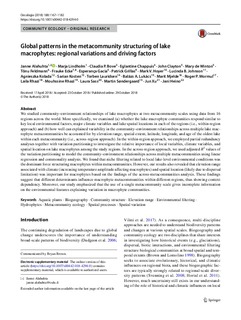Global patterns in the metacommunity structuring of lake macrophytes: regional variations and driving factors
| dc.contributor.author | Alahuhta, Janne | |
| dc.contributor.author | Lindholm, Marja | |
| dc.contributor.author | Bove, Claudia P | |
| dc.contributor.author | Chappuis, Eglantine | |
| dc.contributor.author | Clayton, John | |
| dc.contributor.author | de Winton, Mary | |
| dc.contributor.author | Feldmann, Tõnu | |
| dc.contributor.author | Ecke, Frauke | |
| dc.contributor.author | Gacia, Esperança | |
| dc.contributor.author | Grillas, Patrick | |
| dc.contributor.author | Hoyer, Mark V | |
| dc.contributor.author | Johnson, Lucinda B | |
| dc.contributor.author | Kolada, Agnieszka | |
| dc.contributor.author | Kosten, Sarian | |
| dc.contributor.author | Lauridsen, Torben | |
| dc.contributor.author | Lukács, Balázs A. | |
| dc.contributor.author | Mjelde, Marit | |
| dc.contributor.author | Mormul, Roger P | |
| dc.contributor.author | Rhazi, Laila | |
| dc.contributor.author | Rhazi, Mouhssine | |
| dc.contributor.author | Sass, Laura | |
| dc.contributor.author | Søndergaard, Martin | |
| dc.contributor.author | Xu, Jun | |
| dc.contributor.author | Heino, Jani | |
| dc.date.accessioned | 2019-05-14T09:06:03Z | |
| dc.date.available | 2019-05-14T09:06:03Z | |
| dc.date.created | 2019-02-18T10:51:35Z | |
| dc.date.issued | 2018 | |
| dc.identifier.citation | Oecologia. 2018, 188 (4), 1167-1182. | nb_NO |
| dc.identifier.issn | 0029-8549 | |
| dc.identifier.uri | http://hdl.handle.net/11250/2597526 | |
| dc.description.abstract | We studied community–environment relationships of lake macrophytes at two metacommunity scales using data from 16 regions across the world. More specifically, we examined (a) whether the lake macrophyte communities respond similar to key local environmental factors, major climate variables and lake spatial locations in each of the regions (i.e., within-region approach) and (b) how well can explained variability in the community–environment relationships across multiple lake macrophyte metacommunities be accounted for by elevation range, spatial extent, latitude, longitude, and age of the oldest lake within each metacommunity (i.e., across-region approach). In the within-region approach, we employed partial redundancy analyses together with variation partitioning to investigate the relative importance of local variables, climate variables, and spatial location on lake macrophytes among the study regions. In the across-region approach, we used adjusted R2 values of the variation partitioning to model the community–environment relationships across multiple metacommunities using linear regression and commonality analysis. We found that niche filtering related to local lake-level environmental conditions was the dominant force structuring macrophytes within metacommunities. However, our results also revealed that elevation range associated with climate (increasing temperature amplitude affecting macrophytes) and spatial location (likely due to dispersal limitation) was important for macrophytes based on the findings of the across-metacommunities analysis. These findings suggest that different determinants influence macrophyte metacommunities within different regions, thus showing context dependency. Moreover, our study emphasized that the use of a single metacommunity scale gives incomplete information on the environmental features explaining variation in macrophyte communities. | nb_NO |
| dc.language.iso | eng | nb_NO |
| dc.publisher | Springer | nb_NO |
| dc.rights | Navngivelse 4.0 Internasjonal | * |
| dc.rights.uri | http://creativecommons.org/licenses/by/4.0/deed.no | * |
| dc.title | Global patterns in the metacommunity structuring of lake macrophytes: regional variations and driving factors | nb_NO |
| dc.type | Journal article | nb_NO |
| dc.type | Peer reviewed | nb_NO |
| dc.description.version | publishedVersion | nb_NO |
| dc.rights.holder | © The Author(s) 2018 | nb_NO |
| dc.source.pagenumber | 1167-1182 | nb_NO |
| dc.source.volume | 188 | nb_NO |
| dc.source.journal | Oecologia | nb_NO |
| dc.source.issue | 4 | nb_NO |
| dc.identifier.doi | 10.1007/s00442-018-4294-0 | |
| dc.identifier.cristin | 1678191 | |
| cristin.unitcode | 7464,30,19,0 | |
| cristin.unitname | Ferskvannsøkologi | |
| cristin.ispublished | true | |
| cristin.fulltext | original | |
| cristin.qualitycode | 1 |
Tilhørende fil(er)
Denne innførselen finnes i følgende samling(er)
-
Publikasjoner fra Cristin - NIVA [2160]
-
Scientific publications [1172]

